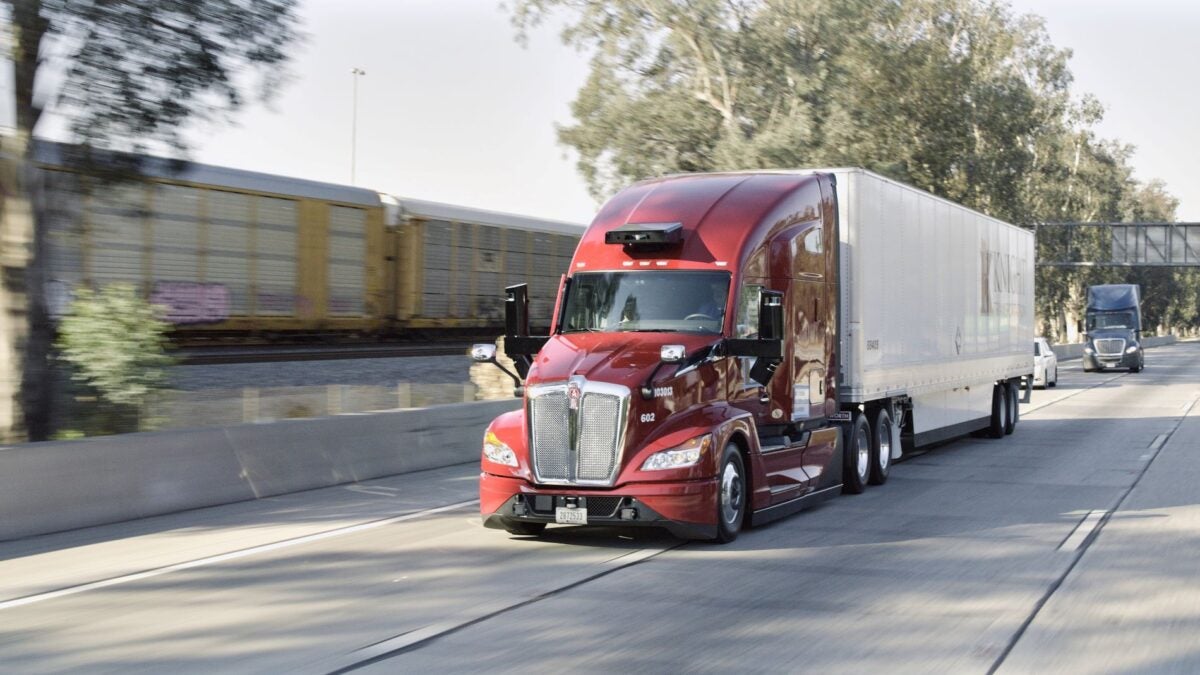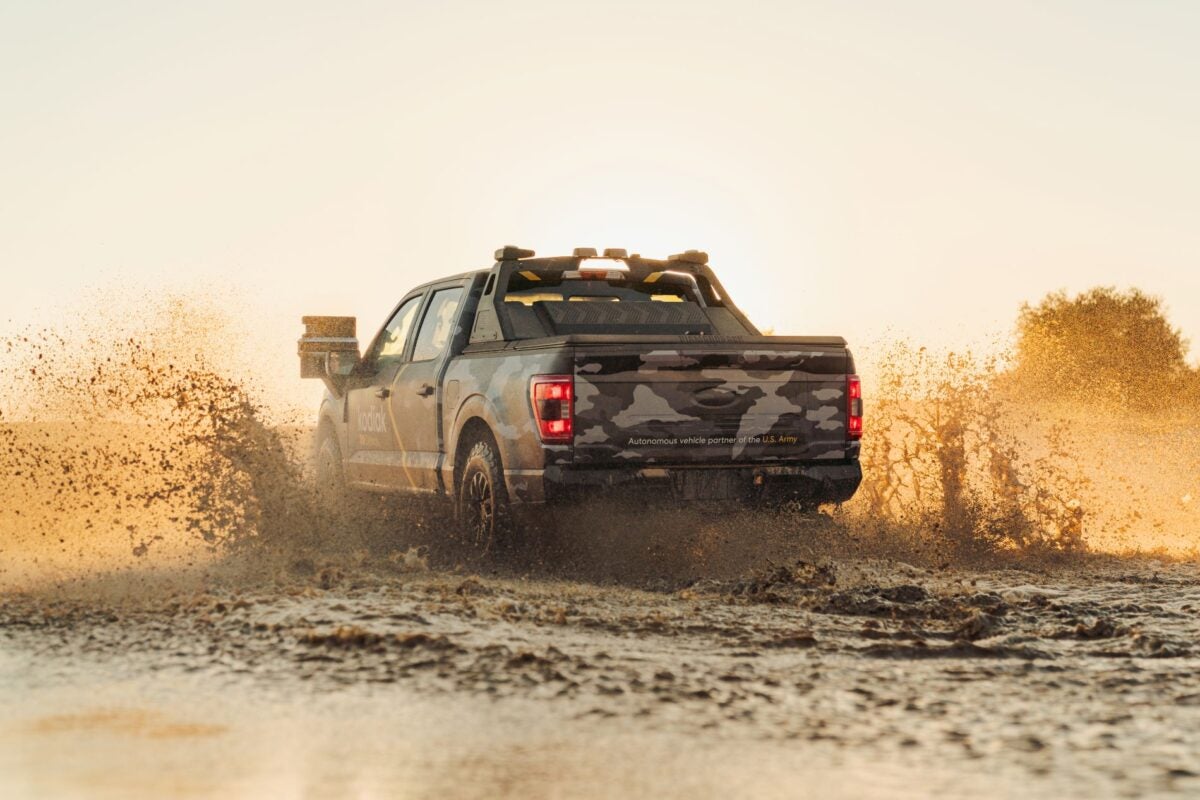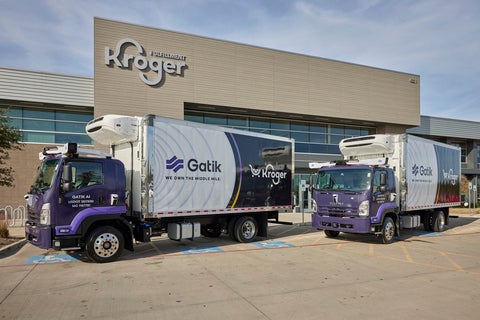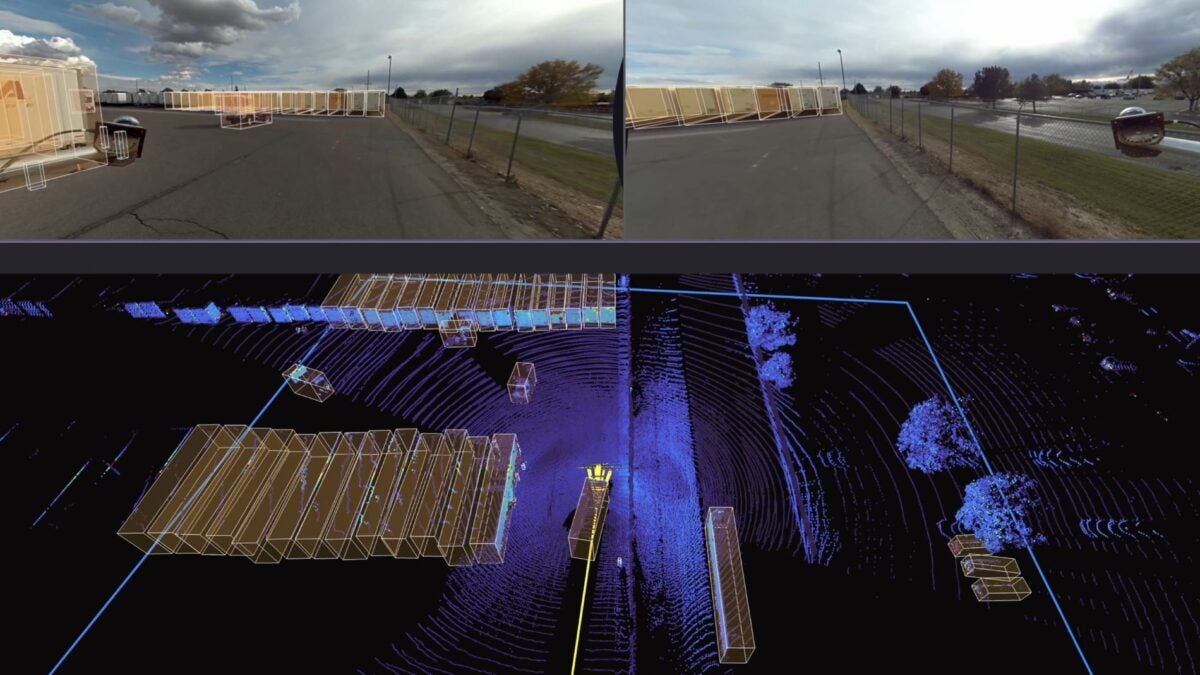The shakeout in autonomous trucking struck in full force in 2023, leaving three leaders targeting commercial routes without humans in the cab and a couple of late entries on the periphery.
Embark Trucks became the first to fall in March, laying off 70% of its San Francisco-based employees and prompting an emotional goodbye from co-founder Alex Rodrigues.
Rodrigues and mid-20s co-founder and college buddy Brandon Moak stood to garner hundreds of millions when Embark went public via special purpose acquisition merger with Northern Genesis Acquisition Corp. in November 2021.
“I’m sorry that myself and Brandon weren’t able to find a way,” Rodrigues wrote in an email to employees. “You are an amazing team and it has been the highlight of my life to get to work with all of you.”
Embark spent most of the $314 million received in its SPAC. Investors redeemed $300 million in shares at the last minute, depriving Embark of additional working capital. Embark had no manufacturing partner, marketing its robotic driver system as an OEM-agnostic add-on.
Venture capitalists and investors who loved the promise of autonomous technology when borrowing was cheap refocused on profits when the cost of money rapidly rose. Embark’s financial prospects dimmed after a 1-for-20 reverse stock split in August 2022. The company’s share price had drifted below $1, exposing it to delisting from the Nasdaq.
With no one coming forward to lend Embark money, the company considered liquidation before selling itself in May to Applied Intuition, an autonomous simulation business, for $71 million in cash.

Waymo chooses robotaxis over trucking
As Alphabet Inc., the parent of Google, looked for ways to cut costs, its “other bets” found themselves vulnerable. Waymo Via, the commercial trucking arm of the ride-hailing company Waymo, found itself repeatedly in the crosshairs. Layoffs beginning in March ended with the practical shutdown of the trucking startup in July while work continued on robotaxi programs in several cities.
But Waymo had to tread lightly because of a relationship with market-leading Daimler Truck. Waymo continues to work on a redundant chassis for the Freightliner Cascadia involving mechanical backups for key systems like steering, braking and low-voltage power.
Waymo left open the possibility of returning to the trucking space, but all projects save for Daimler were shelved.
How much Waymo is working with Daimler is unclear. Daimler’s independent subsidiary, Torc Robotics, received a test version of the redundant chassis in November. It plans for driverless commercial trucking in 2027.
TuSimple looks east
Perhaps the most unexpected departure in the autonomous shakeout was that of TuSimple, acknowledged as a leader from the time of its 80-mile driver-out pilot in December 2021. That might have been the last good thing to happen at the San Diego-based startup with separate operations in China.
The layoff of 25% of its U.S. workforce a year ago preceded a second round of cuts in May, just weeks after TuSimple celebrated 10 million miles of supervised autonomous driving in the U.S. That was followed by the start of a “strategic review” in late June, when TuSimple said it might leave the U.S. market to focus on China and Japan.
In early December, TuSimple pulled the plug, keeping just enough U.S. workers to wind down operations in the first quarter of 2024. Finances at TuSimple remain strong: The company had $776.8 million in cash, cash equivalents and short-term investments at the end of the third quarter.
The impetus to focus on China may have come from co-founder Mo Chen, who has businesses there. He also controls 59% of TuSimple’s voting stock. The pivot away from U.S. operations follows the December 2022 breakup with Navistar International after a 2 ½-year manufacturing partnership and reverses plans to sell or spin off TuSimple China operations. In fact, the company has accelerated autonomous testing in China and Japan.
Clearout makes Aurora Innovation a defined leader
The clearout of Embark, Waymo Via and TuSimple left Aurora Innovation, invigorated by more than $800 million in new capital, and privately held Kodiak Robotics vying for the mantle of leadership. Both plan to commercialize driverless routes in Texas by the end of next year.
“At a time when markets remain uncertain, raising such a large amount from some of Wall Street’s most sophisticated investors demonstrates the market’s belief in Aurora’s progress and our ability to commercialize autonomous vehicles at scale,” a company spokesperson said in an email to FreightWaves in July.
Aurora has established transfer hubs in Houston and south of Dallas, where it runs scores of hub-to-hub driver-monitored autonomous loads weekly. Aurora, led by O.G. Chris Urmson as CEO, has methodically checked off its list of imperatives to safely remove the human driver.
Aurora said in April that its system is “feature complete” and all that remains is validation and improving performance.
The Pittsburgh-based company partners with OEMs Paccar Inc. and Volvo Group in redundant chassis development. They have backup capabilities to steer and stop in the event of a critical component failure. The trucks also pull to the side of the road, known as fallback, when they encounter a problem.
Kodiak Robotics exhibits leadership, too
Kodiak made headlines throughout the year, first by hiring former USA Truck CEO James Reed as its chief operating officer and de facto mentor to CEO Don Burnette, a former graduate assistant to Urmson at Carnegie Mellon University.
Burnette worked for Urmson in the Google Self-Driving Car Project that became Waymo before launching Kodiak in 2018 with Paz Eshel, who took a position early this year with General Motors to help build out its hydrogen energy business.
Kodiak’s finances are opaque because the Mountain View, California-based startup is private. But it ended the year showing a prototype of its Kodiak Driver autonomous system on a Ford F-150 pickup truck prototype for the military. Kodiak received a grant for up to $50 million from the U.S. Department of Defense a year ago to apply its technology to the armed forces.

“Finding applications of technology that can apply to a military use case simultaneously with a civilian and commercial use case is the future, because that’s where the efficiency is,” Burnette told FreightWaves in early December.
As for raising more money, Burnette is optimistic if circumspect.
“The conversations are certainly turning more positive,” he said. “The whole community is starting to ease up. And this is a momentum-driven business. When investors think other investors are poised to jump, that kind of creates a little bit of a springboard effect.”
Torc Robotics’ deliberate approach also looks like a winner
Being an independent subsidiary of Daimler Truck means Torc Robotics doesn’t have to worry much about resources. Sure, CEO Peter Vaughan Schmidt must be as accountable as he was when he ran global autonomous operations for the German truck maker. He oversaw the March 2019 deal that brought Torc into the Daimler fold.
Since taking over as CEO in October 2022, Schmidt has driven the discipline that separates a small growth company from one whose scaling plans resemble those of its parent company. Test routes with safety drivers and engineers cover 1,000 miles from Phoenix to Oklahoma City. C.R. England and Schneider are early participants.
Torc sees commercialized autonomy from the Mexico border to as far north as St. Louis as its initial driverless route in 2027. But it is letting Daimler’s loyal customer base make that call. Torc’s unparalleled advantage is access to Daimler’s customer base.
What about the other guys?
If the leadership picture for Level 4 high-autonomy trucking is becoming clearer, it is not yet complete.
Two AI-focused startups — Waabi Innovation and Stack AV — are just getting started.
Waabi partnered with Uber Freight in a 10-year deal to test its Waabi Driver system. To be fair, Uber Freight partners with multiple autonomous trucking startups as it seeks to share a rich database of route density while adding supervised autonomous capacity to what CEO Lior Ron said is 100 companies in queue to try moving freight autonomously.
Stack is run by former Argo AI autonomous passenger car founders, including Brian Salesky. Its specific plans remain opaque, but the 70 years of combined robotic vehicle experience among its founders suggests Stack could be a force to be reckoned with.
Backed by Japan’s Softbank with $1 billion — according to a local business development official in Pittsburgh where Stack is headquartered — resources are not in question. Salesky declined to confirm that figure to FreightWaves.
On the middle mile and in the distribution yard
There is more to the autonomous trucking landscape than on-highway freight movement.
Gatik, another Mountain View startup, continued to dominate the short-haul middle mile for autonomy, adding regular operations for grocery giant Kroger in the Dallas area and signing Northwest Arkansas-based Tyson Foods to a three-year contract in September that could lead to expansion to as many as 40 of Tyson’s distribution markets.
Unlike Class 8 autonomy, Gatik has practically no competition in driverless distribution routes.

Autonomy also works in the distribution yard. Startup Outrider not only raised $73 million in a Series C round in January, but it continued to add features to driverless yard tractors and an autonomous ecosystem focused on safety in moving and positioning trailers.
Outrider’s yard automation solution now understands, anticipates and interacts with fixed and moving actors in the yard. The updated perception system allows Outrider to achieve critical safety and performance objectives for commercial driverless operations in 2024.

Related articles:
Aurora Innovation raises $820M in fresh capital
Gatik robot trucks will haul Tyson chicken, sausage and hot dogs








Jeffrey Anderw
Please beware of scammers, this people are everywhere, I invested £37,350 with scam broker FXG trade and never got my money back and they kept asking for more which I couldn’t meet up with their demands, so they never got back to me anymore and i was so desperately in need of help to recover all the money back to me, fortunately I came across a colleague that introduced me to a binary options trade funds recovery expert who goes by the name Mr Lucas Jones when i met them i did not believe that they could get back my money because i have been scammed a lot already and didn’t know what to do, but my spirit told me to give it a try and i did, feel free to contact them via their email address: patrickmaikb44@gmail.com and they will help you to recover all your lost investment that was denied from you by your scam broker.
Mike Jones
Onward to the next AI scam. 😂 Where The investors can be taken to the cleaners.